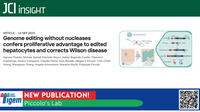Authors: Agnese Padula, Michele Spinell, Edoardo Nusco, Xabier Bujanda Cundin, Filomena Capolongo, Severo Campione, Claudia Perna, Amy Bastille, Megan E Ericson, Chih-Chieh Wang, Shengwen Zhang, Angela Amoresano, Mariana Nacht, Pasquale Piccolo
Year: 2023
Sources: JCI Insight
Abstract:
Application of classic liver-directed gene replacement strategies is limited in genetic diseases characterized by liver injury due to hepatocyte proliferation resulting in decline of therapeutic transgene expression and potential genotoxic risk. Wilson disease (WD) is a life-threating autosomal disorder of copper homeostasis caused by pathogenic variants in copper transporter ATP7B and characterized by toxic copper accumulation, resulting in severe liver and brain diseases. Genome editing holds promise for the treatment of WD, nevertheless to rescue copper homeostasis ATP7B function must be restored in at least 25% of the hepatocytes, which surpasses by far genome editing correction rates.
We applied a liver-directed nuclease-free genome editing approach, based on adeno-associated viral vector (AAV) -mediated targeted integration of a promoterless mini-ATP7B cDNA into the Alb locus. Administration of AAV-Alb-mini-ATP7B in two WD mouse models resulted in extensive liver repopulation by genome edited hepatocytes holding a proliferative advantage over non-edited ones, and ameliorated liver injury and copper metabolism. Furthermore, combination of genome editing with a copper chelator currently used for WD treatment, achieved greater disease improvement compared to chelation therapy alone.
Nuclease-free genome editing provided therapeutic efficacy and may represent a safer and longer lasting alternative to classic gene replacement strategies for WD.
Category: journals

